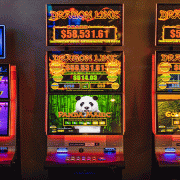US CASINOS LOSE 43,400 SLOT MACHINES IN PAST DECADE
According to a recent report by Deutsche Bank, slot machines are disappearing at an alarming rate from the floors of commercial US casinos.
Deutsche analysed 12 US casino companies that operate a total of 120 properties. They discovered a 21 percent decline in the number of slot machines since 2007. This amounts to an aggregate loss of 43,400 machines.
“All 12 operators in our analysis have culled their floors,” read the report. It concludes, “We believe this trend is likely to continue into the foreseeable future as operators shift financial resources to other amenities and continue to seek efficiency on floors.”
The 12 casino operators on which the report based its findings were Ameristar Legacy Assets, Caesars Entertainment, Isle of Capri Legacy Assets, Eldorado Resorts, Pinnacle Entertainment, Boyd Gaming & Peninsula Assets, Las Vegas Sands, Mohegan Tribal Gaming, MGM International Resorts, Penn National Gaming/GLPI. Red Rock Resorts and Wynn Resorts
What’s replacing slot machines?
Not too long ago, it was slot machines that were replacing other games (poker rooms in particular) or underperforming amenities on casino floors. Slots were seen as a casinos’ best square-metre “bang for their buck”.
This is no longer the case, for two reasons:
- Gaming habits are changing, particularly among millennials
- Casinos are realising better revenue streams from other, non-gaming sources
Gaming habits are changing
A new generation of casino-goers are shunning slot machines. This has the industry scrambling to re-design slots and/or games. But when you consider the number of first-time visitors to Las Vegas is growing and the average age of visitors is decreasing, it’s clear that attracting millennials isn’t the problem.
Despite higher visitation, millennials simply aren’t gambling. But then again, this age bracket was never going to produce much in the way of gaming revenue. Even if they do develop millennial-friendly slot machines, the number of slots on the casino floor is unlikely to increase. Casinos have found they can make as much or more money from non-gambling visitors.
Non-gaming margins are higher
Beginning with Steve Wynn’s shift to destination resorts when he built the Mirage — and later Bellagio, Wynn, and Encore — the industry has been increasingly pivoting toward non-gaming revenue with higher margins — hotel rooms, food, nightclubs, and other forms of entertainment.
Casinos are no longer giving these things away as comps to lure in gaming dollars. Instead, they’re charging a premium for them because of the experience that accompanies a trip to a true resort casino. At some point, this change might reach a complete role reversal, with gaming being the comp to lure people to the hotels, shops, and entertainment venues offered at luxury casinos.
Casinos have long undervalued their hotels and amenities. They used to give them away as door prizes to anyone who set foot on the casino floor. But as it turns out, it’s the amenities and the four or five -star hotel experience that makes people want to part with their hard-earned dollars. This is particularly true among the younger visitors, who prefer to gamble at their convenience (online or at regional casino properties) rather than travel to gamble.
UNLV’s David Schwartz recently wrote that hotel rooms will soon overtake gambling in terms of revenue: “If the current trend continues, by 2019, rooms will make about as much money as the casino floor, in 2020 they will surpass it, and by 2023, Las Vegas Strip resorts will make about $2 billion more from their rooms than their gambling.”
Beyond rooms, non-gaming revenue has been gaining steam for decades.
Per the Press of Atlantic City:
“In 1989 nongaming revenue represented 21 percent of total casino revenue; as of 2015, it represents 29 percent. For casino industry leader Las Vegas, the shift is even more distinct from a 60/40 split gaming vs. nongaming in 1989 to a 35/65 split in 2015.”
Don’t put slots on the endangered species list just yet
This isn’t necessarily a warning to slot machine manufacturers, or regional casinos, clubs and pubs … at least not yet.
In addition to slot manufacturers adapting to current trends — skill-based slot machines (including touch screen table gaming) and virtual reality technology — the report notes that Mohegan Tribal (the only tribal casino operator examined) saw the smallest decline of its 12 companies. As one gaming analyst noted on Twitter, there is more to it.
Todd Eilers @EilersResearch “Saw analyst report out saying slot floors have been shrinking. Simply not true. Yes, Commercial casinos are down, but Tribal & Route are up!”
Along the same lines, the report notes the largest operators (casinos with 10,000 or more slots) have been the most aggressive when it comes to removing slot machines. This makes sense, as it’s the amenities and experiential nature of a billion-dollar (or multi-billion-dollar) casino that attracts people.
Basically, the bigger the casino and the casino market, the less it needs to rely on gaming revenue.
But it is a trend that operators of all sizes and in all locations can’t ignore. Millenniels aren’t going to go away and the club, pub and casino models of 10 or 20 years ago, are not going to be relevant to your future audiences. The question is, how is your venue going to engage with your market in the next decade and beyond. Will you be ready, or not?
Article by Steve Ruddock, USPoker >> http://www.uspoker.com/blog/casinos-slashing-slot-machines/17120/











